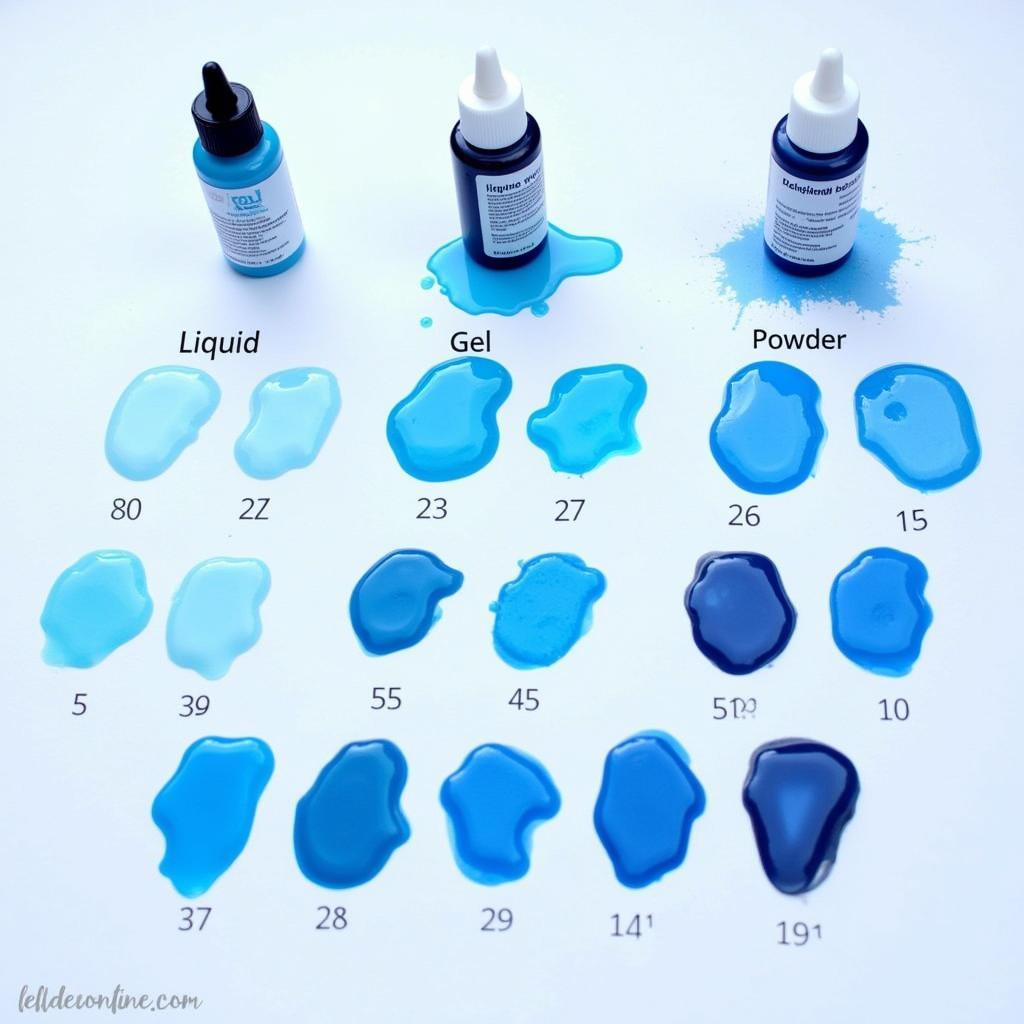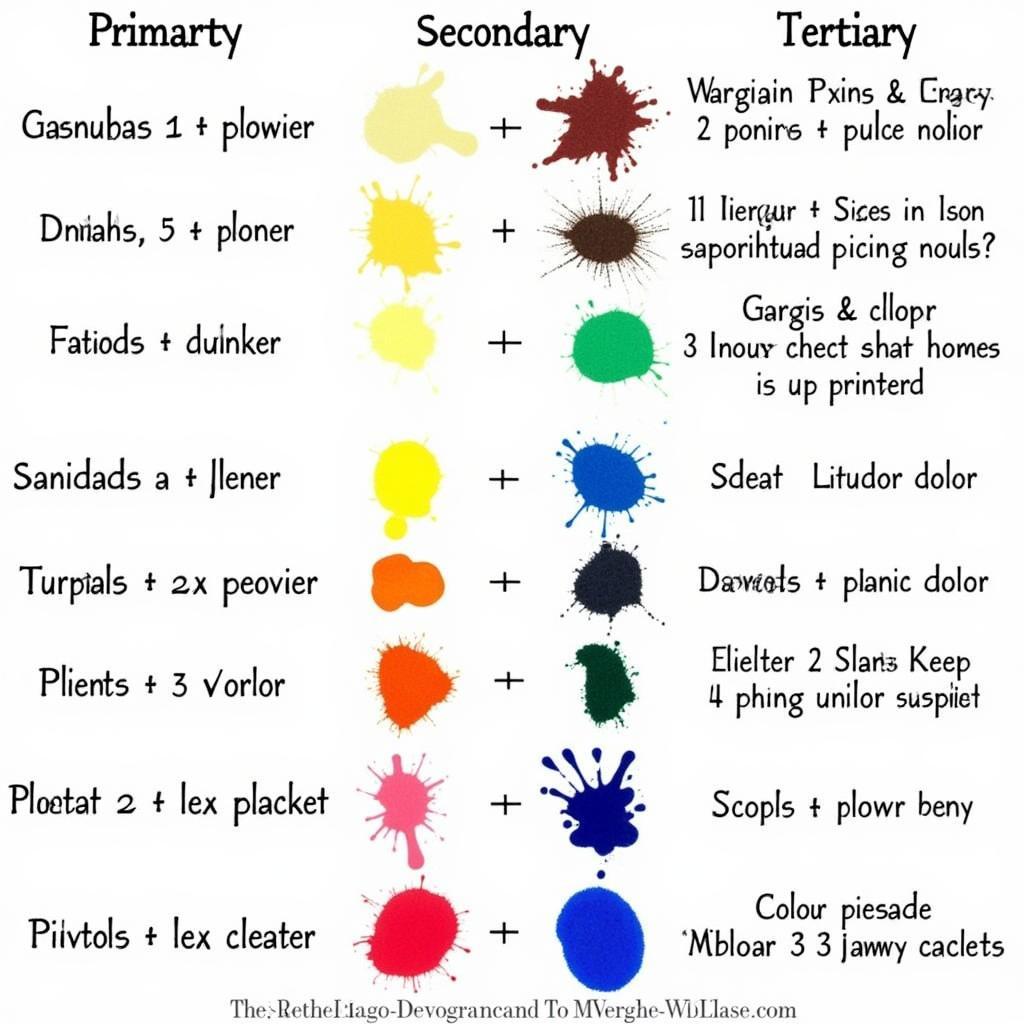Food coloring opens up a world of vibrant possibilities in the kitchen, transforming ordinary treats into edible masterpieces. This guide will delve into the fascinating world of food coloring, providing you with a comprehensive Food Coloring Color Guide to help you achieve the perfect hues for your culinary creations. We’ll cover everything from basic color mixing to understanding different types of food coloring, ensuring you become a true color master in your kitchen.
Understanding Food Coloring Types
Before diving into our food coloring color guide, it’s essential to understand the different types available. Each type possesses unique properties, impacting color intensity and application methods.
- Liquid Food Coloring: This is the most common type found in supermarkets. It’s easy to use but can be less concentrated, requiring more drops for vibrant colors.
- Gel Food Coloring: More concentrated than liquid, gel food coloring offers vibrant hues with fewer drops. It’s ideal for achieving deep, rich colors in baking and frosting.
- Powdered Food Coloring: Highly concentrated, powdered food coloring is perfect for coloring large batches or achieving specific shades. However, it requires careful mixing to avoid clumping.
- Natural Food Coloring: Derived from plants and vegetables, natural food coloring offers a healthier alternative. While achieving vibrant colors can be challenging, it caters to those seeking natural ingredients. You can explore more about natural food coloring options at where can i buy natural food coloring.
Creating a Rainbow: Your Food Coloring Color Guide
This food coloring color guide will equip you with the knowledge to create a spectrum of colors. Remember, the type of food coloring you choose will affect the final result.
Primary Colors: The Foundation
- Red: A powerful and vibrant color, red is a staple in many recipes.
- Blue: From pastel skies to deep ocean hues, blue offers a range of possibilities.
 Blue Food Coloring Shades
Blue Food Coloring Shades - Yellow: A cheerful and bright color, yellow adds a sunny touch to your creations.
Secondary Colors: Mixing Magic
- Green: Combine blue and yellow to achieve a refreshing green.
- Orange: Mix red and yellow for a vibrant orange.
- Purple: Blend red and blue to create a regal purple.
Expanding Your Palette: Tertiary Colors and Beyond
By combining primary and secondary colors, you can create a vast array of tertiary colors. Experimenting with different ratios will unveil endless possibilities. For intricate designs, you might consider learning how to paint with food coloring.
“Understanding color theory is crucial when working with food coloring,” says renowned pastry chef, Amelia Dubois. “Start with small amounts and gradually add more until you achieve the desired shade. Remember, practice makes perfect!”
Tips for Using Food Coloring
- Start Small: Begin with a few drops and add more as needed. It’s easier to add color than to remove it.
- Mix Thoroughly: Ensure even distribution of color for consistent results.
- Consider Your Canvas: The base you’re coloring will influence the final color. White frosting will produce more vibrant results than a darker base.
- Lighting Matters: Natural daylight is best for assessing color accuracy.
- For intricate designs, consider airbrush food coloring. For a touch of sparkle, you can explore glitter food coloring. For pure white shades, check out americolor white food coloring.
 Food Coloring Mixing Chart
Food Coloring Mixing Chart
“Don’t be afraid to experiment!” encourages food stylist, David Nguyen. “Food coloring is a versatile tool that allows you to express your creativity in the kitchen.”
Conclusion
This food coloring color guide provides a solid foundation for exploring the world of color in your culinary adventures. By understanding the different types of food coloring and mastering basic color mixing techniques, you can transform your dishes into vibrant works of art. Remember, practice and experimentation are key to unlocking the full potential of this colorful tool. So, grab your food coloring and let your creativity shine!
FAQ
- What type of food coloring is best for frosting? (Gel food coloring)
- How do I avoid streaks when coloring batter? (Mix thoroughly and gradually)
- Can I mix different brands of food coloring? (Yes, but results may vary)
- How do I achieve pastel shades? (Use a small amount of color in a white base)
- What is the best way to store food coloring? (Tightly sealed in a cool, dark place)
- How can I make brown food coloring? (Combine red, blue, and yellow)
- Are there vegan food coloring options? (Yes, many brands offer vegan-friendly options)
For further assistance, please contact us at Phone: 02437655121, Email: [email protected] or visit us at 3PGH+8R9, ĐT70A, thôn Trung, Bắc Từ Liêm, Hà Nội, Việt Nam. We have a 24/7 customer service team.